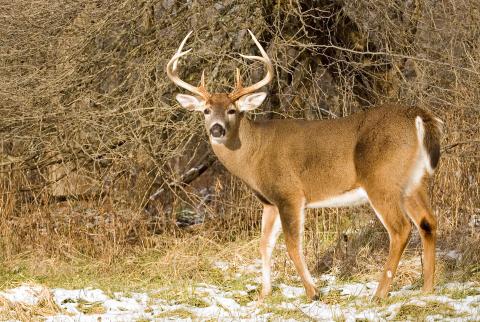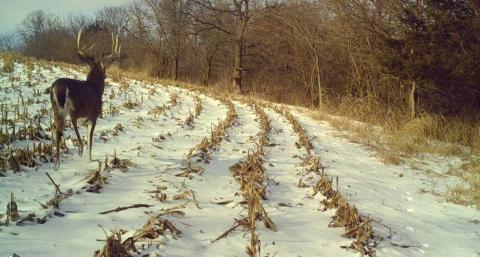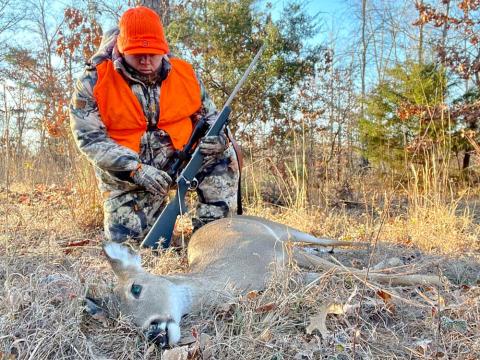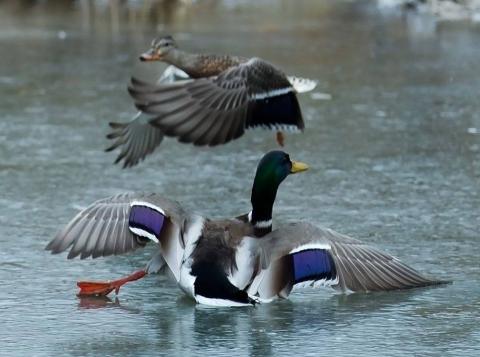Lisa Thompson is a Mossy Oak ProStaffer from Littleton, Colorado.
Getting Started Elk Hunting
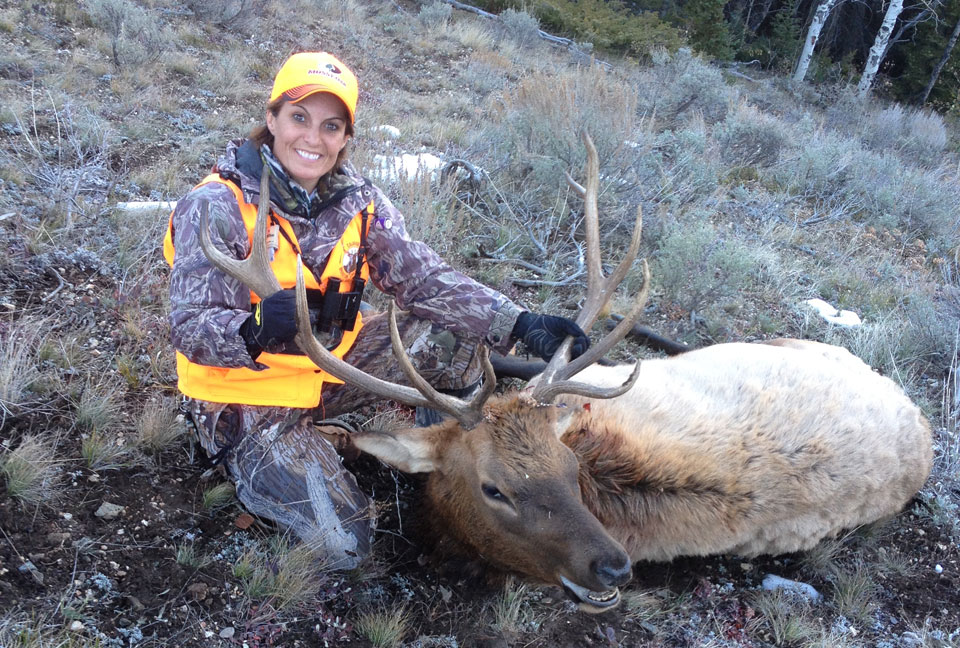
I was raised with hunters, and I’ve always had many family members and friends who were elk hunters. So, to me, my becoming an elk hunter was natural. Although I’ve been hunting elk for more than 30 years, in the last five years, I’ve seen a tremendous increase in the number of women wanting information not only on elk hunting but also on hunting in general. When I teach classes for Cabela’s or Bass Pro Shops, we have many more women in attendance than ever before. When I go to the International Sportsmen’s Expos, I see more women walking the aisles. I think, today, there’s more information being put out on websites, TV and in newspapers and magazines than ever in the history of the sport. I’m a part of the Hunting Divas Facebook page and more women are coming to that page each year. So, I’m convinced more women are looking for hunting information today.
The number-one question from women who are new to hunting is simply, “how do I get started.” Start by taking a hunter’s education course through your local game and fish department. In that course, ladies can learn all the different types of weapons with which they can hunt, including bows, rifles and muzzleloaders, and they get to shoot all those various weapons. They’ll also learn to identify the animals they can hunt and take. In Colorado where I live, and other states, you’re required to take a hunter-education program course. Then I think it’s important to define why you want to hunt. Are you primarily being a sport hunter, or do you want to harvest meat for you and your family? I want to understand why that person wants to hunt elk.
When someone answers that she wants to learn to hunt elk, then her next questions will be about gear. Because I’ve hunted for so many years and have tested numerous types of gear made for ladies, I recommend they study the clothing and gear market, save their money and buy the best equipment possible at the price they want to pay.
In the mountains where you hunt elk, the weather can be very cold and wet. You’re a long way from home, and you don’t want to get hypothermia. So, when you’re considering footwear, clothing and rain suits, always buy the very best gear you can afford.
Since about 23% of the families in America today are single-mother families, hunting elk enables a lady to take an animal that provides plenty of nutritious meat for her and her children. If these women are fortunate enough to take elk, that meat will save their families money they would have spent on buying meat.
My hunting partner Donnelle Johnson and I took 12 single ladies turkey hunting this past year. While sitting around a campfire, we asked them what their families thought about their getting into hunting. More than half of them told us their families didn’t think they should be involved in hunting. So, we’ve learned from many of the outdoors women with whom we’ve connected that they want to become hunters and especially elk hunters, because that’s something they personally want to do. I always suggest that the first few times they go elk hunting that they go with an experienced elk hunter who’s willing to take her to experience what elk hunting is. That’s one of the purposes of the Hunting Divas Facebook page. We try to find someone to help ladies interested in getting into elk hunting to learn the sport.
Another place where a lady can go for information to begin to hunt elk is a Facebook page titled “i Hunt Colorado” that was started by Curtis Mock. This forum allows you to ask questions, and many ladies find hunting buddies there. This forum has more than 30,000 members, so there’s always someone willing to help.
Map Your Way to an Elk
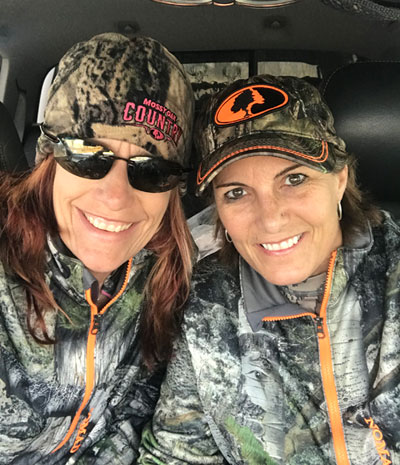 Ladies can begin to hunt elk at their homes by learning to use maps. The number-one concern of most women - and even men who may not admit it – is the fear of getting lost. You can avoid that problem if you have a digital map that shows where your vehicle and your campsite are, where you are, and how to return to your vehicle and/or your campsite. Digital maps also can buy you from one to possibly three more hours of hunting time for a day. Until you have confidence in your ability to read a map quickly and easily, you won’t get up before daylight, and you won’t come out of the woods after dark. First light and last light often are the most productive times to see elk.
Ladies can begin to hunt elk at their homes by learning to use maps. The number-one concern of most women - and even men who may not admit it – is the fear of getting lost. You can avoid that problem if you have a digital map that shows where your vehicle and your campsite are, where you are, and how to return to your vehicle and/or your campsite. Digital maps also can buy you from one to possibly three more hours of hunting time for a day. Until you have confidence in your ability to read a map quickly and easily, you won’t get up before daylight, and you won’t come out of the woods after dark. First light and last light often are the most productive times to see elk.
When the mountains are wrapped in darkness, you can’t identify landmarks nor can you in rain or snow. You can’t see where you’ve been or where your vehicle and campsite are located. But by using maps, you can see the trail that you’ve come in on, and you can backtrack when you’re ready to come out of the woods. Or, by knowing where your vehicle or your camp is, you may be able to take a shorter route back to them.
Another advantage that digital maps give elk hunters is you may take an elk, but you’ll still need to mark the spot where that elk is located and start carrying the meat out. You may have to make several trips from the elk to your vehicle and back. The digital map will show you where you are, where you’ve downed the elk, where your vehicle is, how far you must travel to reach your vehicle, and how to return to your elk.
Often the best time of the day to take an elk is during that last 30 minutes of daylight. However, many hunters won’t hunt then, due to their being afraid that they may have to try to walk out of the mountains in the dark. But if you’ve mapped your hunt, this concern is one you don’t have to fear. I work with www.HuntData.com, and this company offers numerous maps and digital software that can be fed to your Smartphone from satellites circling the earth. These digital maps enable you to hunt as far from you vehicle as you want to hunt without getting lost.
I’ve read that hunters who start hunting at least a mile away from the nearest road have a 95% better chance of harvesting an animal than the hunters who hunt a mile or less from an access road. You can get the HuntData maps on your hand-held GPS receiver, or you can get them on a Smartphone. Many people don’t realize that when they hold their phones they’re holding one of the best GPSs made. Each Smartphone has a satellite chip inside of it. With a Smartphone, you can be in the wilderness with no service to call home or send and receive emails or text to let anyone know where you are. But your cell phone still can reach satellites and show where your vehicle is, and where the animal you’ve harvested is located.
You’ll always have your cell phone with you. So, put your cell phone in Airplane Mode. Then the cell phone will turn off all your emails, text and other notifications, and you’ll save your battery. But you still have your GPS that works. And, when you want to call home, climb to the top of a mountain, take your cell phone off Airplane Mode, and then you can call and/or text home. That means you’ll have one piece of equipment that enables you to connect to the outside world and also shows you where you are, and how to return to from where you’ve come.
Yet another advantage to using your cell phone is the screens on your cell phone are larger than the screens on a hand-held GPS. So, you can see where you are and where you want to go much easier. Also, when you buy a hand-held GPS receiver, there’s often 20-40 pages that you need to read to understand and use that GPS. However, when you use HuntData maps, you’ll only have one page to read that tells you how to use the maps to navigate, mark waypoints and return to your vehicle. If you don’t understand the instructions, you can call HuntData, and the company will answer any questions and show you how to do anything you want to do with their maps and your cell phone.
Bone the Elk to Get the Elk Meat Out
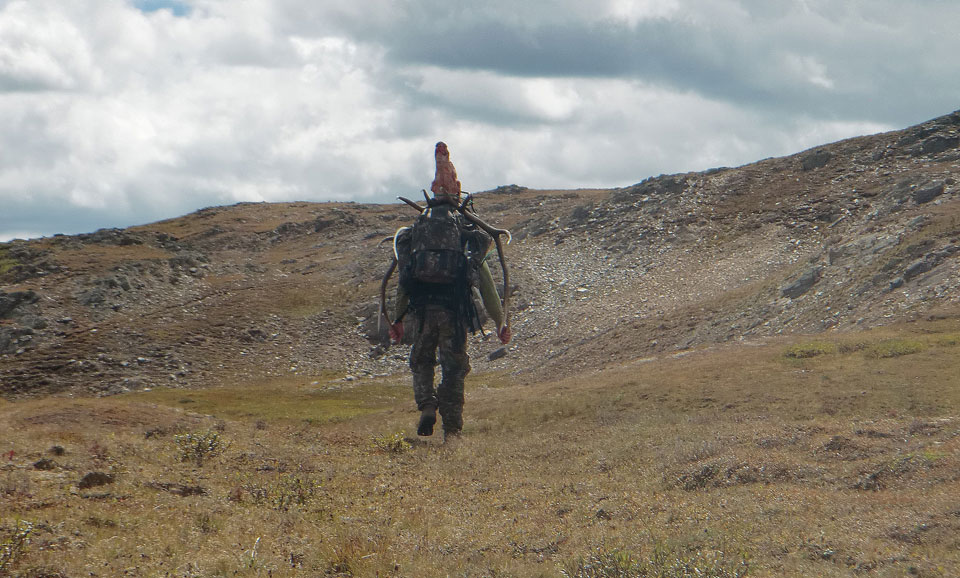
The concern about getting an elk back to the vehicle or camp after a successful hunt is why most novice elk hunters - male or female – don’t hunt more than a mile from their vehicles. But if you bone out the meat, you don’t have nearly the weight of that 800-pound animal to try to move. When people attempt to drag an 800-pound animal out like they would a white-tailed deer, they’ll usually have to go to a doctor or a chiropractor afterwards.
I haven’t field dressed an animal since 2002 when I learned how to bone all the meat out and leave most of the weight of the animal behind. I still can reach in and get the heart out for my mother-in-law, if she wants it, I can get the backstrap and the tenderloins out, and I can get the meat off the front shoulders, hindquarters and the neck without having to gut the animal and skin it before I start removing the meat. Then you can put the meat in gamebags and carry it out on your back, a horse or a game cart. I only take out one bag at one time – generally about 50-60 pounds. I pack out my own elk meat by myself and walk several miles during the process.
If I carry out the antlers and the cape as well as the meat, and I’m by myself, I’ll usually have to make about five trips to my vehicle to get the entire elk out. That’s why I always recommend that ladies find a hunting partner. Then they’ll have other hands and backs to carry out the meat more quickly. I generally can carry the meat from the front shoulders and the tenderloins out on my first trip. That’s why you need to get to know the other people in camp and learn how to contact them. With myself and two other hunters, we can pack out an elk in one trip back to my truck. If I’m hunting with my husband, he can carry 120 pounds at a time in his pack.
If I’m bowhunting, generally two or three other people will be hunting near me. Whoever gets an elk is then helped by the other people in my party. Another advantage of elk hunting with one or two other people that you can reach by phone is that you have people you can call on if you get sick or hurt or need help of any kind. When hunting in the mountains, spraining an ankle or falling are easy accidents to have. Having other people with you hunting is always good.
If you’re hunting by yourself, there’s a hand-held emergency device called SPOT that when you push a button, it gives the receiver on the other end your exact location. Then that person can get help to you quickly. I’m looking at a device like this for the people I take hunting for their first time sometimes on group hunts. My hunting partner Donnelle and I take 10 women on horseback into the wilderness with no cell service. If someone gets hurt, I want to be able to alert someone.
Have Quality Boots and Survival Equipment
When you’re looking at equipment for an elk hunt, women should save their money and buy the best equipment possible – especially boots. I’ve field tested a wide variety of boots over the years when I’ve been hunting elk. I know that all feet aren’t the same. For instance, I have a narrow foot with a high arch. I’ve finally settled on wearing Kenetrek boots. My hunting partner and I both wear these boots that are made in Bozeman, Montana, that come with an orthotic in them and are form-fit to your foot. The number of miles you can put on a pair of those boots and them hold up great is amazing. If you don’t wear a good boot when elk hunting, your hunt usually will be ruined the first day out.
I guide both men and women to elk, and those people pay a lot of money to go on their hunts. To have to stay in camp after a first day of hunting due to your not having a quality pair of boots and having blisters on your feet doesn’t make sense to me. I also strongly suggest that you get your boots long before you hunt and wear them to climb hills, steps and mountains to break them in and to help them be very comfortable when you’re wearing them on your elk hunt.
Besides boots, another critical ingredient for a successful and comfortable elk hunt is what you carry in your daypack. Temperatures can change dramatically in a very short time when you’re elk hunting. You need to have clothes and equipment that you can be comfortable in. I always recommend that elk hunters layer their clothing. In the mornings, the weather may be chilly, and you’ll need a light coat or jacket. I’ll also wear long underwear and a long-sleeved shirt. Usually by mid-afternoon or evening, the weather’s warmed up, I’ll generally take all that off and put it on the inside or the outside of my pack.
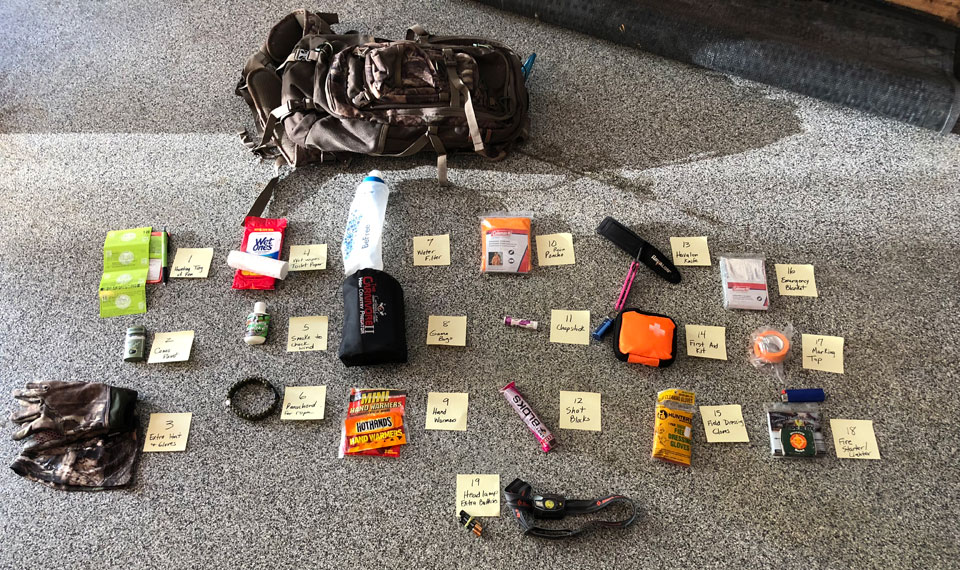
Elk Hunting Needs
- Lots of water. Instead of packing water, I suggest a water filter like the LifeStraw Personal Water Filter that’s lightweight, small and easy to pack, allows you to drink out of any river or creek and filters out bacteria that may make you sick.
- Matches and something else like a Zippo cigarette lighter. There’s other equipment available to start fire other than with matches like fusees that are safety flares railroads use. Since matches or your match striker can get wet, you need something else to start a fire that moisture won’t affect.
- Food if you get caught in a snowstorm or a rain storm. Always bring a sandwich or candy bars with you. I always take Shot Bloks with me that will give you a burst of energy to help you get up the mountain or down off the mountain. Marathon runners use these energy snacks for training and competing.
- A lightweight rain poncho that packs up small in case of rain or snow and a space blanket for warmth.
- A knife in my pack – not just to bone out an elk but to trim shavings off wood to start a fire or for other purposes.
- A head light, since I hunt until dark and need the light to see to get out of the woods, and extra batteries for the head light.
- A small flashlight to use to see to put new batteries in my head lamp if it goes out.
- A balaclava or some type of sock hat, since I generally wear a baseball ball cap when hunting if the weather’s okay.
- An extra pair of gloves
- Game bags to put the meat in.
- A small first aid kit with Band-Aids, Motrin, an allergy pill (because I have allergies), a bandage wrap and a tourniquet – not just for me. I may come up on another hunter who’s injured or perhaps one of the people I’m guiding may have problems.
Although I take a lot of “stuff” in my pack, all this equipment is light and easy to compact.
While you may or may not have an interest in hunting elk, getting outdoors and enjoying nature by fishing, hiking, boating, or viewing wildlife is a great way to spend time with your friends and family. So, go outside! There's always something to learn in the Great Outdoors.
















